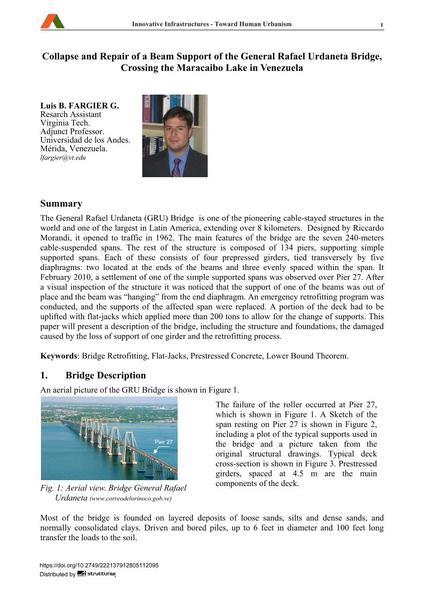Collapse and Repair of a Beam Support of the General Rafael Urdaneta Bridge, Crossing the Maracaibo Lake in Venezuela

|
|
|||||||||||
Bibliographic Details
| Author(s): |
Luis B. Fargier
|
||||
|---|---|---|---|---|---|
| Medium: | conference paper | ||||
| Language(s): | English | ||||
| Conference: | 18th IABSE Congress: Innovative Infrastructures – Towards Human Urbanism, Seoul, Korea, 19-21 September 2012 | ||||
| Published in: | IABSE Congress Seoul 2012 | ||||
|
|||||
| Page(s): | 1528-1535 | ||||
| Total no. of pages: | 8 | ||||
| DOI: | 10.2749/222137912805112095 | ||||
| Abstract: |
The General Rafael Urdaneta (GRU) Bridge is one of the pioneering cable-stayed structures in the world and one of the largest in Latin America, extending over 8 kilometers. Designed by Riccardo Morandi, it opened to traffic in 1962. The main features of the bridge are the seven 240-meters cable-suspended spans. The rest of the structure is composed of 134 piers, supporting simple supported spans. Each of these consists of four prepressed girders, tied transversely by five diaphragms: two located at the ends of the beams and three evenly spaced within the span. It February 2010, a settlement of one of the simple supported spans was observed over Pier 27. After a visual inspection of the structure it was noticed that the support of one of the beams was out of place and the beam was “hanging” from the end diaphragm. An emergency retrofitting program was conducted, and the supports of the affected span were replaced. A portion of the deck had to be uplifted with flat-jacks which applied more than 200 tons to allow for the change of supports. This paper will present a description of the bridge, including the structure and foundations, the damaged caused by the loss of support of one girder and the retrofitting process. |
||||
| Keywords: |
prestressed concrete bridge retrofitting Flat-Jacks Lower Bound Theorem
|
||||
